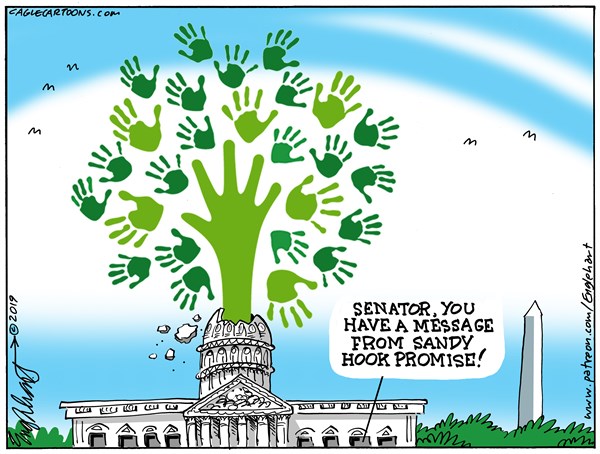Gun Violence: Doctors ‘in Their Lane’ Saving Lives
Public Health Approach Can Reduce Deaths

“More Americans died from firearms in the last 50 years than in all of the wars in American history. Since 1968, more than 1.5 million Americans have died in gun-related incidents, according to data from the U.S. Centers for Disease Control and Prevention (CDC). By comparison, approximately 1.2 million service members have been killed in every war in U.S. history, according to estimates from the Department of Veterans Affairs and iCasualties.org.” (Chelsea Bailey, 10-04-17)
In February, 45 of the largest medical, legal and injury-prevention organizations in the U.S. came together for an inaugural medical summit on firearm injury prevention. They reached a historic agreement to recognize firearm violence as a public health crisis in the U.S. and supported a comprehensive public health approach to solve it. They postulated that immediate steps can be taken toward a public health approach to the firearm crisis. We must change the conversation from a polarized debate about “gun control” to a common effort to address “firearm injury prevention.” We must approach firearm deaths and injuries as a public health problem instead of a political problem. Finally more investment in research is needed to better understand and more effectively address the epidemic of violence caused by firearms.
The Dickey Amendment has prevented research into gun violence needed to set policies and laws. This amendment is a 1996 provision which mandated that none of the funds made available for injury prevention and control at the CDC may be used to advocate or promote gun policies. The amendment was lobbied for by the National Rifle Association.
In California, research into various aspects of gun violence has been conducted by Garen J. Wintemute, an emergency medicine physician at UC Davis Medical Center. Wintemute is the director of the Violence Prevention Research Program (VPRP), a multi-disciplinary program of research and policy development at the University of California, Davis. Thirty years ago this program began to develop a public health approach to firearm violence.
Before Wintemute received a California grant, he spent over $1 million of his own money to do research on gun violence. He was appointed director of California’s gun violence research center, the first state-funded effort of its kind. The Firearm Violence Research Center opened at UC Davis in 2017, with $5 million in California government dollars to use over five years. Wintemute conducts research in the fields of injury epidemiology and the prevention of firearm violence.
Trauma surgeons with more than 60 years of collective experience caring for victims of firearm violence are experiencing largest wave of mass firearm violence in modern history in America. Political battles over “gun control” rage on, resulting in no meaningful actions to reduce firearm injuries and deaths.
A solution to this impasse is exemplified by a public health approach to the prevention of death and disability from motor vehicle crashes. In 2017 — for the first time — deaths in the U.S. from firearms surpassed those from motor vehicle crashes. The reduction in automobile fatalities required significant investment in research to develop the most effective interventions along with substantial effort by the medical and public health community.
Using the example of the public health approach, similar progress is possible to reduce firearm deaths and injuries. It requires working together across political divisions to make firearm ownership as safe as possible, while also working to understand and address the root causes of violence.
About 60 percent of all gun deaths in the U.S. are suicides. The other reasons for firearm deaths are — assault, unintentional injury (such as children with access to unsecured, loaded firearms) and mass violence with a firearm. Motor vehicle deaths have been on a steady decline using proven public health-based injury prevention strategies. As a society, we recognized the problem and committed to addressing it at both federal and state levels. We have made automobiles safer and improved roadway design. Necessary automobile safety legislation was enacted. And now necessary firearm legislation clearly must be addressed: universal background checks, banning assault weapons and large capacity magazines, all of which have majority public support. A public health model is the only approach to reducing firearm violence which would recognize the need to develop interventions that address firearm violence and help reduce deaths and injuries.
The Coalition Against Gun Violence 24th Annual Celebration, “Doctors ‘In Their Lane’ Saving Lives” takes place Sunday, September 29, 2019 at the Santa Barbara featuring three keynote speakers and first responders from Cottage Hospital Doctors, Robert Kanard, MD, Sara Nimmons, MD and Jason Prystowsky, MD who will share their stories as witnesses to firearm injuries. For tickets and reservations, see sbcoalition.org.
Ref: Los Angeles Times 9-13-19 article by Eileen M. Bulger, professor of surgery, University of Washington School of Medicine and chair of the American College of Surgeons Committee on Trauma. Ronald M. Stewart, chair, Department of Surgery of UT Health in San Antonio, Texas, and medical director of trauma programs at the American College of Surgeons.
Toni Wellen is chair of the Coalition Against Gun Violence.



